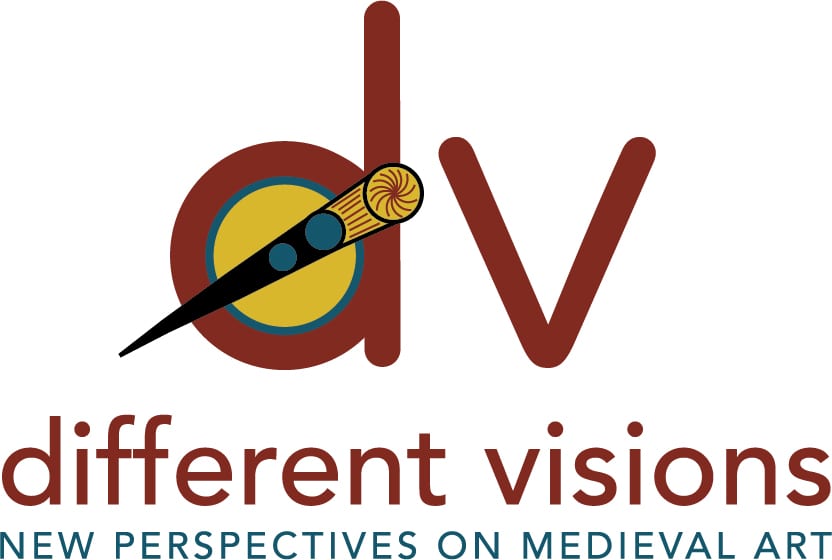Tory Schendel-Vyvoda • Evansville African American Museum
Recommended citation: Tory Schendel-Vyvoda, “A Reflective Journey: Connections to Medievalism and the Middle Ages,” Different Visions: New Perspectives on Medieval Art 11 (2025). https://doi.org/10.61302/IXXY2137.
Introduction
Whenever working with the human experience, especially narratives, it is imperative to nuance the dialog, when able, through the collection of oral histories and implementing them into the conversation. Therefore, when graciously invited to write an article about my connection to the Middle Ages and medievalism, I phoned family members and messaged former professors and friends for memories and commentary about my exposure to the subject. After interviewing individuals near and dear to me, coupled with self-reflection and multiple drafts of this article, I discovered there has only been one overarching theme throughout my life: the medieval period. Whether in speculation and fantasy, or through academic scholarship, authoring this article taught me that I have always loved and cherished the Middle Ages, and it only makes sense that I continue to serve as a practicing medievalist, albeit in an abstract manner. Therefore, this article is broken down into sections of time, throughout my life, to serve as a reflective essay about my lifelong connection to medievalism.

This is a picture of me living my best medievalism life outside of Medieval Times in Chicago, Illinois. We visited to celebrate my son’s second birthday in 2022. Photo Credit: Mark Vyvoda.
The Nuclear Family & Their Impact: 1992-2006
Nestled in Northwestern Indiana, my small family lived in a Fort Wayne, Indiana rural subdivision. Although my mom and dad were divorced, it made no difference to us. My mother worked at Lincoln Financial Group as a telephone operator, and my father worked as a Midwest Tool & Die plant manager. Aside from their day jobs, Tami (mom), and Jeff (dad), created a household that valued family, imagination, creativity, nature, singing songs, and history. Tami continues to be a history buff captivated by the Tudor period. Between her nightstand full of books about the Tudors and other medieval and Renaissance monarchs and her watching the BBC on all things historical–her passion indirectly fueled my studies because she made the era familiar and accessible. Unlike my mother, Jeff is an outdoors person who loves Mopar cars, fishing, camping, and having beers around a campfire. Although Jeff was not into the Middle Ages, per se, he taught me to value nature and to practice land stewardship. He continues to emphasize that humans are not placed on this Earth to control nature but must learn how to live alongside the planet and find joy in life’s quietest moments. Unbeknownst to my dad, his treatment of nature and respect for life mirrors the medieval philosophies of mysticism. Between the two of them, access to the period and the core values of my parents helped shape an environment that nurtured my curiosity for medievalism. Nonetheless, it is essential I reflect on the many ways in which my older sister, Tara Schendel, encouraged my interest with the era through fantasy medievalism.
Tara is an anime, Pokémon, and video game lover. While she works for PNC bank as a telephone operator, her passion for fantasy and creativity has never dwindled. She expresses herself through food as she indulges her culinary talent in the United States Army Reserves as she works as a cook. When she has free time, she makes fantastic dishes to be shared with the family. Growing up, Tara and I always shared a room, and I credit our impeccable bond today to our forced closeness as kids. Most of our summers were spent in Georgetown Square, a small shopping center approximately fifteen minutes by bike from our dad’s home in Valley Meadows, Fort Wayne, Indiana. The square had a library, comic bookstore, video game store, and board game shop. We spent our summers among these various locations, indulging in medievalism and growing a connection to fantasy. At the library, the Georgetown branch held Dungeon & Dragon workshops. Participants would not only learn about the game, but could also attend a workshop to learn how to paint miniatures (small statuettes of the characters from the game). This led to us going to the Books, Comics & Things store to buy more miniatures and spend our free time painting them. After we gathered a small collection of figurines and connected with locals who attended the workshops, we eventually learned that Top Shelf Games, a board game shop across from the library, held weekend Dungeon & Dragon sessions in which we participated throughout middle school and most of high school.
Furthermore, Tara and I were obsessed with the Squaresoft videogame franchise: Final Fantasy. In 1998, Dad bought us a Play Station. With it, our first two games were Steel Reign, a game focused on tank warfare, and Crash Bandicoot, a genetically enhanced bandicoot who tries to save the world from the evil Cortex and save his girlfriend, Tawna.[1] From there, we participated in Pizza Hut’s Pay Station Demo disc series,[2] in which we were introduced to Spyro, Tony Hawk, Tomb Raider, MediEvil, and Final Fantasy VIII. From the demo disc, we were instantly hooked on Final Fantasy. We tested the game at McVan’s Video Games in Georgetown Square and eventually convinced Dad to buy it for us. Medievalisms are abundant in every game of the series for those unfamiliar with the franchise. With dragons, knights, magic, royalty, scriptoriums, and castles, each game in the series brings pieces of the medieval world to life. To add to our collection, we eventually purchased Final Fantasy V through X-2 and Tactics by saving up our $5.00 allowance, shoveling snow off driveways during the winter, and eventually working at Taco Bell.
The High School Years with Friends: 2006-2010
Throughout high school, our passion for Final Fantasy and Dungeons & Dragons remained; however, we could dive deeper into medievalism thanks to some fantastic friends. Also, big gamers and fans of medieval fantasy, Codey Fischer, Hitesh Mistry, Justin Castleman, and Nick Jacobs, significantly impacted Tara and my young adult life. Codey, Hitesh, Justin, and Nick were neighbors from our mom’s house in the Stillwater subdivision in Fort Wayne, Indiana. We played Phantasy Star Online, Mario Party, and the computer game Diablo on the weekends. We also ran around the neighborhood LARP-ing (Live Action Role Playing game) with homemade or replica swords with the plot line of one “house,” or clan, family, etc., fighting against another, and we needed to stop the “enemy” from advancing. In 2008, we traveled to Indianapolis, Indiana, to attend our first Gen Con: North America’s largest tabletop game convention.[3] We cosplayed various anime characters, and I was Tifa from Final Fantasy VII. At the convention, we indulged in medieval fantasy by participating in LARP sessions inside the convention building, attended panels about Dungeons & Dragons, and visited the various booths to see their medieval-inspired wares for sale.
In addition to our travels, Codey, Hitesh, Nick, Tara, and I were dawning on a new era in human history: the age of technology. Dial-up internet access was becoming more accessible to middle-class families, and in 2005, the video-sharing platform YouTube.com became an important pastime in documenting our shared adventures.[4] When discussing this article with Codey, Hitesh, Nick, Justin, and Tara, I realized that the YouTube links shared in our group chat were fantastic memories I had forgotten. With our Meijers or Walmart point-and-shoot cameras, we recorded birthday parties, travels, and various other wanderings of teenagers. We photographed cookouts, sleepovers, card games, LARP-ing events played at our homes, and staged silliness with props at Glen Brook Square Mall in Fort Wayne.
This video from 2008 demonstrates some of our fun with our friends. With permission from the collective, I chose this clip because there are many scenes of us LARP-ing. Video Credit: Hitesh Mistry and Codey Fischer.
Nonetheless, our videos became increasingly advanced as we became more familiar with our cameras and modern technology. For example, inspired by the videogames, tabletop games, and anime we watched, during Tara’s 16th birthday at my dad’s house, the collective produced the story 3 Swords Tale. The saga was about how every one-hundred-years, three swords fell from the heavens, and three warriors would assemble to use them and fight to be crowned the next king of the samurai! In the video, Codey, Tara, and our classmate Brett would fight for the honor, or so they thought.
To all our surprise, the 2006 video, 3 Swords Tale, survived! Permission was granted from all parties to use the full video in this article. Video Credit: Hitesh Mistry and Codey Fischer.
In another video, we created the Story of Burger King. This tale was about our king, or the “Burger King,” challenging the other kingdoms in the realm, or the other fast-food chains such as Taco Bell and McDonald’s, to win the hand of the fair maiden Wendy and make her our queen.[5] While the connection to medievalism throughout my upbringing was abundant, the fantasy pivoted to scholarly in 2010.
Germany & Its Life Changing Impact: 2010
I was accepted into the Indiana University Honors Program for Foreign Language during my senior year of high school. The program focuses on providing an intense summer language immersion experience for Spanish, German, and French speakers.[6] Since I studied German throughout high school, I was fortunate to spend my summer in Krefeld, Germany, learning German culture, grammar, phonetics, music, day-to-day conversation, and literature.

This building served as our schoolhouse in Krefeld, Germany, 2010. Photo Credit: Tory Schendel-Vyvoda.
In addition to our studies, we traveled around Germany to bring our in-class lessons to life, and one of our excursions would change my life forever. In Professor Vanessa Domizlaff’s literature class, we studied Karl der Grosse or Charlemagne. We read passages from Einhard’s Two Lives of Charlemagne,[7] learned about the Holy Roman Emperor’s historical context, and examined Charlemagne’s Aachen Cathedral for its artistic and architectural significance. Our unit over Charlemagne would be my first exposure to a multidisciplinary understanding of a medieval ruler and our visit to the Aachen Cathedral was my first exposure to medieval art.
I will never forget the experience of visiting the Aachen Cathedral and viewing the Bust of Charlemagne.
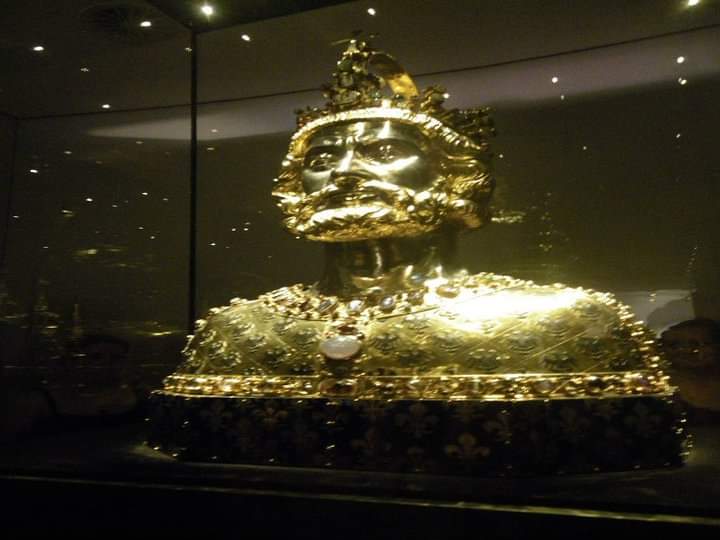
While this photo seems underwhelming, this is the picture I took in 2010 of the Bust of Charlemagne, that changed my life. Photo Credit: Tory Schendel-Vyvoda.
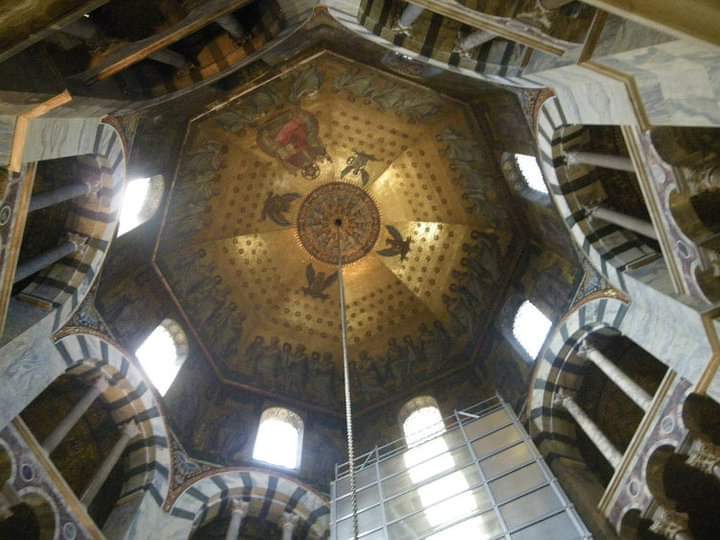
A photograph of the Palatine Chapel. I included this picture because it is the only image I have of the physical space that transformed my world, 2010. Photo Credit: Tory Schendel-Vyvoda.
I not only felt an overwhelming sense as I entered the tremendous architectural structure and was amazed by the Palatine Chapel, but I was immediately stunned when crossing the path of the Bust of Charlemagne. It was the most beautiful object I have ever seen in my entire life. The gold, stones, and composition of the overall artifact aesthetically captivated my whole being, and I felt something inside that I had never experienced before, but at that moment, I proclaimed, whatever this feeling…I want to dedicate my life to it.[8] While in Germany, I started to learn more about museums, artifacts, and the cultural heritage industry. It was significantly impactful that visiting cultural sites was part of our curriculum, and once I had a taste of the museum sector, I became obsessed. I remember sitting on my host-sister’s computer, googling the various jobs in the museum world. Then I stumbled upon the title “curator” and never looked back. Luckily, the Indiana University Honors Program was a transition period before attending Indiana University-Purdue University of Indianapolis (IUPUI). Once I completed the Krefeld program, I embarked on becoming a curator of medieval art.
The Undergraduate Years: 2010-2014
When I returned to the United States, I felt different. For the first time, I had ambition in life. I had a professional goal, and I finally felt a connection to learning and caring about school. I had a purpose at eighteen, which was the most rewarding feeling. Once I moved into my new on-campus apartment at IUPUI, I was off to earn my place as a curator. Within the first week of the fall semester, two miraculous things occurred: I became a Visitor’s Assistant at Newfields (formerly known as the Indianapolis Museum of Art) and learned about IUPUI’s individualized major program (IMP). With my museum job secured, I planned to use my position as a steppingstone to network with the curators in hopes of attaining any curatorial opportunity, and with the knowledge that I could form my own degree at IUPUI, I created a specialized degree in curation as an undergraduate. While this seems overly ambitious, I worked around the clock to make both opportunities occur during my freshman year. In addition to enjoying college life and all its offerings, most of my time was spent studying in the various libraries around the IUPUI campus. I remember being awake during the early hours of the morning to comb through the Indiana University course catalogs to build out my IMP while absorbing everything I could about the Middle Ages. At the end of my Freshman Fall Semester, I was successful in working with Dr. Claudia Grossmann (Department of German Studies), Drs. Susan & Robert Sutton (Department of Anthropology & Classical Archaeology), Dr. Crystine Keener (Department of Art History), Dr. Elizabeth Kryder-Reid (Graduate Department of Museum Studies), Dr. Sharon Wales (Visiting Professor of German Studies and Medieval Studies), Dr. Jennifer Lee (Department of Art History), and Amy Jones Richardson (Director of Recruitment, Retention, and Academic Services), or my IMP committee, to officially recognize my IMP.
Since I was given the freedom to customize my degree with the guidance and mentorship of the IMP committee, classes were selected from across the Liberal Arts to give me a multidisciplinary understanding of the Middle Ages. Due to this, I was exposed to a Middle Ages that had women, diversity, and a global perspective. I studied art history, museum studies, archaeology, anthropology, foreign languages, theology, astronomy, and more. In addition to the on-campus classes, I was able to study abroad every year and see the museums, cultural heritage sites, and artifacts that I studied in-person. I was trained in the trivium like our medieval ancestors.[9] To complement the academic curriculum, I was fortunate to intern for various museums and galleries throughout my tenure at IUPUI. I served as a collections management intern at the Indiana State Museum, curator of contemporary art intern & Clowes Collection curatorial researcher at Newfields, a gallery associate intern at the Robert F. Kennedy Human Rights Gallery in Florence, Italy, and as a conservationist intern at the Archaeology Museum of Paros in Paros, Greece.

In this staged image taken during an interview with a local Indianapolis news station in 2013, I am discussing my fellowship project as the Clowes Curatorial Researcher. My work involved collaborating with Dr. Sharon Wales to analyze the artifact known as the Standing Female Saint, as part of a story about the Individualized Major Program at IUPUI. We learned through our collaboration that she was Saint Barbara. Photo Credit: Tory Schendel-Vyvoda.
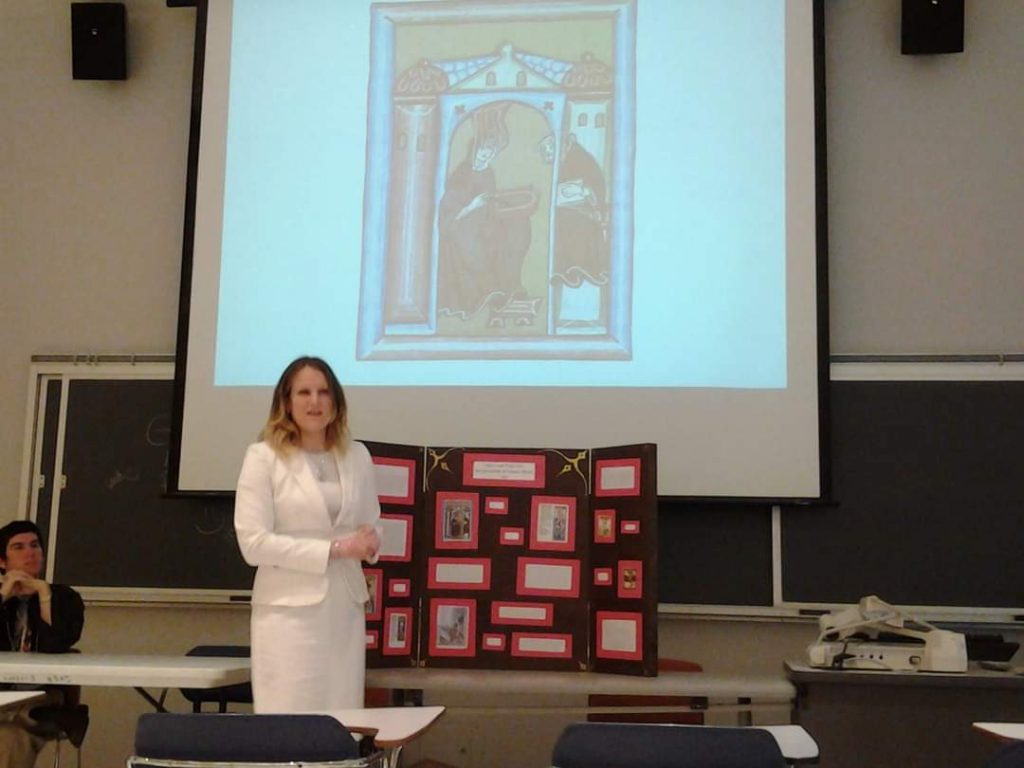
I presented my paper, Optics and Visio Dei: Interpretations of Female Mystic Art, at the Indiana University Women’s and Gender Studies Conference in 2014. Photo Credit: Tory Schendel-Vyvoda.
With the duality of curriculum and professional experience, I also presented my work in medieval art history and research at several conferences and won many academic awards to fund my work and studies. As I progressed through my undergraduate degree, it appeared that I had figured it out and would achieve my dream. However, as we are taught in medieval literature, protagonists rarely achieve their holistic goals.
Post-Undergraduate Years: 2014-2018
When I crossed the threshold of the IUPUI commencement stage, I never knew that I would never work as a traditional medievalist again. After finishing IUPUI, I applied for museum-related jobs, and struck out every time. I thought about applying for a master’s, but the $38,000 in undergraduate debt scared me and I did not want to accumulate more debt. At this point, all the momentum and drive I had cultivated since Germany seemed to be for nothing. I had no idea how to function outside of the undergraduate university system. I had no mentorship on how to move into a curatorial career, nor did I have family members to learn from. Despite the last four years at IUPUI, I felt like an island of one. For the next year, while I earned some museum or gallery internships, I mainly worked several customer service jobs. I worked at a gas station, liquor store, donut shop, and outdoors shop and spent a few months at Pizza Hut. While I did not necessarily enjoy my working conditions, I met great people and was able to maintain my love for the medieval period. By 2014, smartphones had become more ubiquitous and cheaper to obtain. I would run wired headphones through the back of my shirt and connect them to the auxiliary port of my cellphone, located in my back pocket, and listen to YouTube videos about the medieval period. I especially loved the BBC content available on the app and would always have it playing. I also continued my medieval study sessions at the library. Indiana University-Purdue University of Fort Wayne (IPFW) was up the street from where I lived and had a fabulous medieval book collection. Nonetheless, working three jobs and slap-sticking a curatorial career quickly became stale.
In need of a new life in which financial insecurities would not cripple me, I joined the United States Army National Guard. I enlisted in 2015 and went to Fort Jackson, South Carolina, for Basic Combat Training. I appreciated my time in the Army. I served for four years, and while in service, I learned vital skills significant to an aspiring museum professional and scholar. I learned leadership, thinking quickly and flexibly, teamwork, and logistics. Fortunately, I attended army instructor school at the Camp Atterbury Regional Training Institute. While there, we learned how to create course curriculum, studied pedagogy, and learned how to be an instructor and manage a classroom. For our final, we had to create a class with a hands-on exercise. I chose to teach my peers how to create a medieval manuscript.
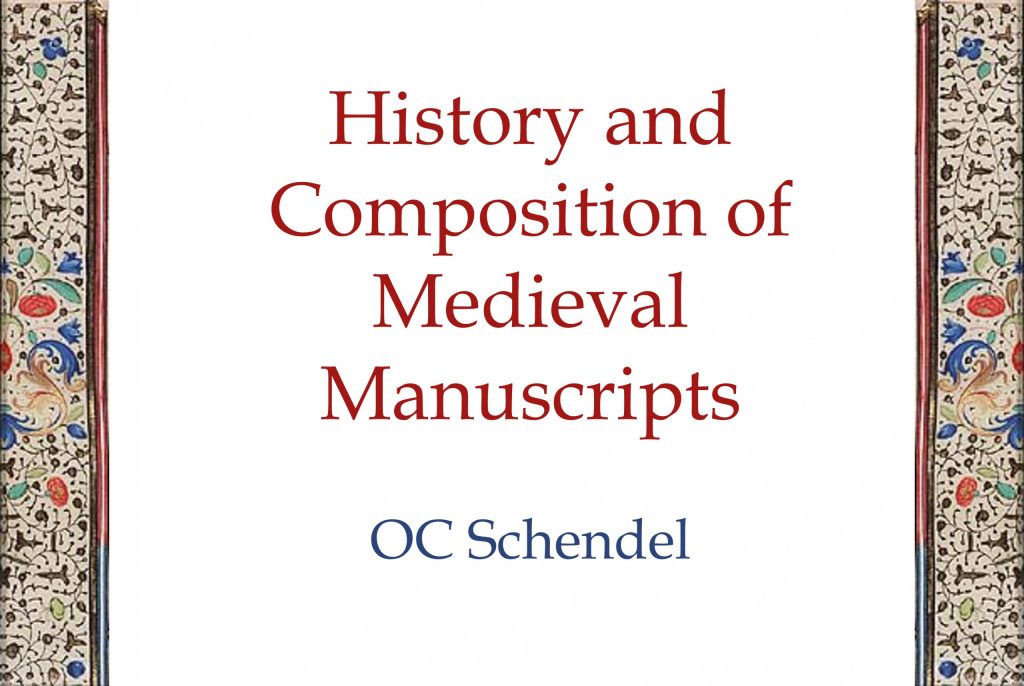
Screenshot of the first slide for my class and workshop for the Army, 2017. Photo Credit: Tory Schendel-Vyvoda.
For the exercise, I bought parchment, inkwells, calligraphy pens, and diagonal boards, and I also had a pamphlet for each soldier demonstrating how to make each letter. Surprisingly, the class lesson was a success. We had infantry, field artillery, Army Ranger, and Special Forces people (I was the only self-identified female in my section) enjoying the content and illustrating beautiful leaves. After my lecture, the sessions concluded for the day; however, something wholesome transpired in the room. Soldiers hung around to continue writing or share their connection to the Middle Ages. One ranger shared his joy for the assignment because, as a boy, he attended a private Catholic School, and had regular classes about manuscripts. The nuns even had him do the same exercise on manuscript writing as in my lesson! Due to the course, my upper leadership learned of my interest in history and museum work. This led to my authorization to work at the Camp Atterbury Museum during the last two years of my enlistment contract.

I am posing with a Slovakian Fujara. In 2019, I curated an exhibition about the positive relationship between Slovakia and Camp Atterbury. Photo Credit: Tory Schendel-Vyvoda.
At the Museum, I cataloged artifacts, curated exhibitions, and conducted classes discussing how the fine arts can positively impact soldiers’ mental health. However, during my last year of military service, I reevaluated my life. While content with my work, I felt a hole in my heart. I wanted to be a full-time curator, not a part-time professional.
A Renaissance: 2018-Present
After further reflection, I recommitted to my curatorial dream, and decided nothing would stop me. I had the confidence to move forward with my professional dream. I applied to graduate school and in 2018, I was accepted into the Johns Hopkins University Master’s in Museum Studies program. This was a massive victory for me in many ways, especially since I had access to phenomenal professors with decades of museum experience. During my second semester, I took the class Curatorship: Principles and Practices with independent curator and lecturer Nik Apostolides. His teaching style was inspired and dynamic, but he also served as the mentor I needed. He worked with me on curatorial job applications, critically reviewed my CV, and met with me over ZOOM to discuss interview strategies. Then, after I submitted my final for his class, a surreal life experience occurred; I was hired by Mary Bower, The John Streetman III Executive Director of the Evansville Museum of Arts, History & Science (EMAHS), to serve as The Virginia G. Schroder Curator of Art in Evansville, Indiana. I oversaw a 40,000-object permanent collection spanning from prehistory artifacts to contemporary artworks across the globe, and it had a medieval collection.
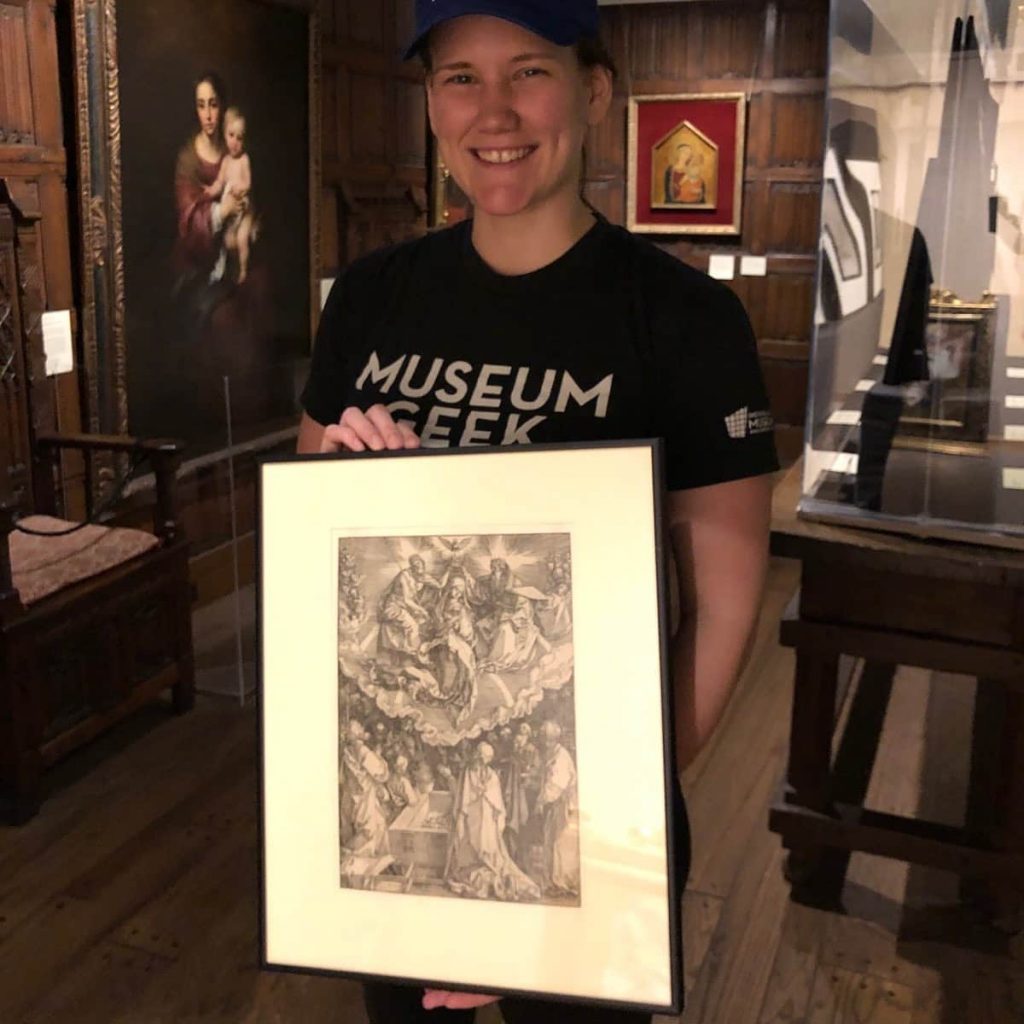
In 2020, I am posing in the EMAHS’s Gothic Room, the space where the medieval and Renaissance collection was on display. Photo Credit: Tory Schendel-Vyvoda.
While working at the EMAHS, I organized exhibitions that had medieval sub focuses, such as Salvador Dali’s Stairway to Heaven, Classical and Medieval Numismatology, and A Celebration of Women: Selected Works from the Permanent Collection. I immensely enjoyed using my passion for the first time to celebrate and elevate the cultural material from the Middle Ages to share stories and narratives relevant to the 21st-century.
Although I was finally a curator, after three and a half years, I was ready for a different curatorial path. I wanted to find a position where I had more flexibility, as I was now a mother, and was allowed more time to write academic journal articles and essays. Then, in 2022, I became the Curator of the Evansville African American Museum (EAAM),[10] where I currently work. Since coming on to the EAAM, I believe my career has taken off in an unimaginable way. Due to the professional love and support from my colleagues, board members, and especially my boss, Kori Miller, I have been pushed academically, mentally, and emotionally to be a better curator and person. While I am not working with much material from the Middle Ages, my understanding of the period’s historical context when discussing Africa or the Western hemisphere has been invaluable for the exhibitions.
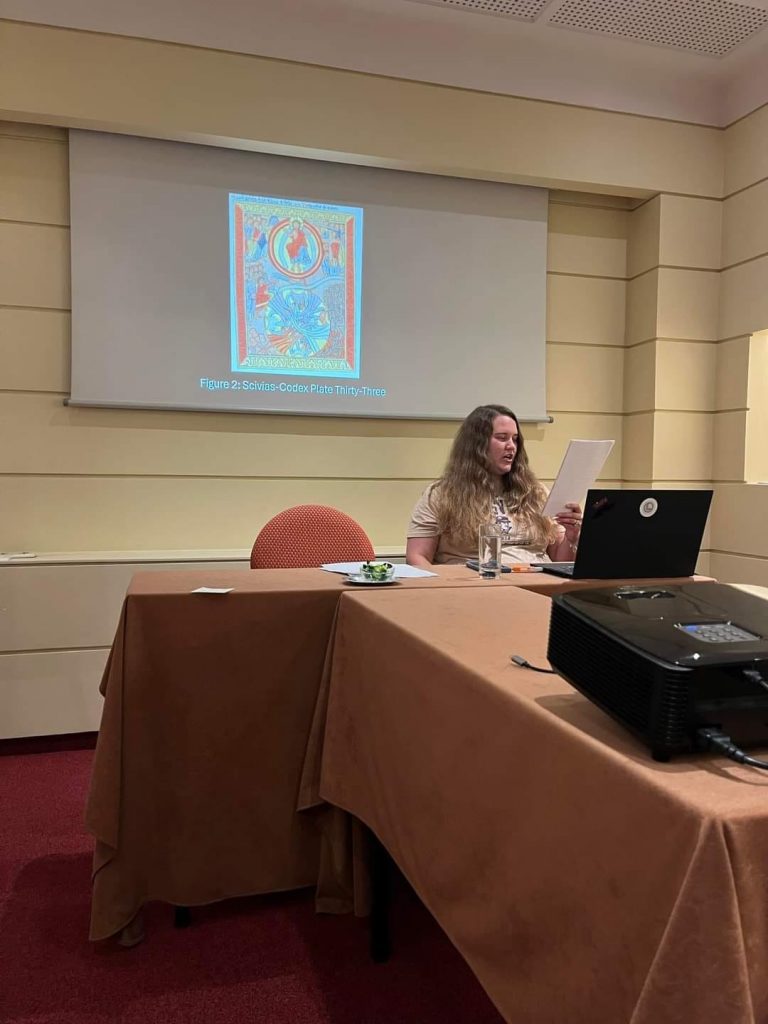
I am presenting my paper Feminist Perspectivism in Schuermann’s Medieval Latin Epoch at the Institute of Doctoral Studies in the Visual Art’s 2024 Summer Doctoral Residency in Athens, Greece. This paper was then published by Magistra: A Journal of Women’s Spirituality in History. Photo Credit: Tory Schendel-Vyvoda.
Furthermore, because of the flexibility of my schedule, I am currently earning my doctorate at the Institute of Doctoral Studies in the Visual Arts, where I focus on the Middle Ages, adjunct lecture for the University of Evansville, created the Lamasco Microgallery to study the impact of neighborhood community engagement through art,[11] volunteer at the University of Southern Indiana to work with their medieval manuscript collection, and have published at least one peer-reviewed article every year since 2020.

I am posing with the first Lamasco Microgallery installation, The Light Princess, by Nina Oberlin in 2023. In 2024, I presented a section on medievalism and the microgallery for the 59th International Congress on Medieval Studies. I asked Nina to write a narrative I could share with the collective. She shared, “When I met Tory…[s]he asked me if I would like to create a microgallery installation with miniature puppets… While talking and hanging out with Tory, I learned about her passion for Medieval art and extensive knowledge of the subject. She gave me so much more appreciation of the period and the stories behind the art. So, I decided to make my exhibit about a knight and a princess.” Photo Credit: Tory Schendel-Vyvoda.

The only “traditional” medieval work I currently conduct is volunteering for the Lawrence Library at the University of Southern Indiana. The collection has approximately two thousand manuscripts from across the globe. This image is from 2022. Photo Credit: Tory Schendel-Vyvoda.
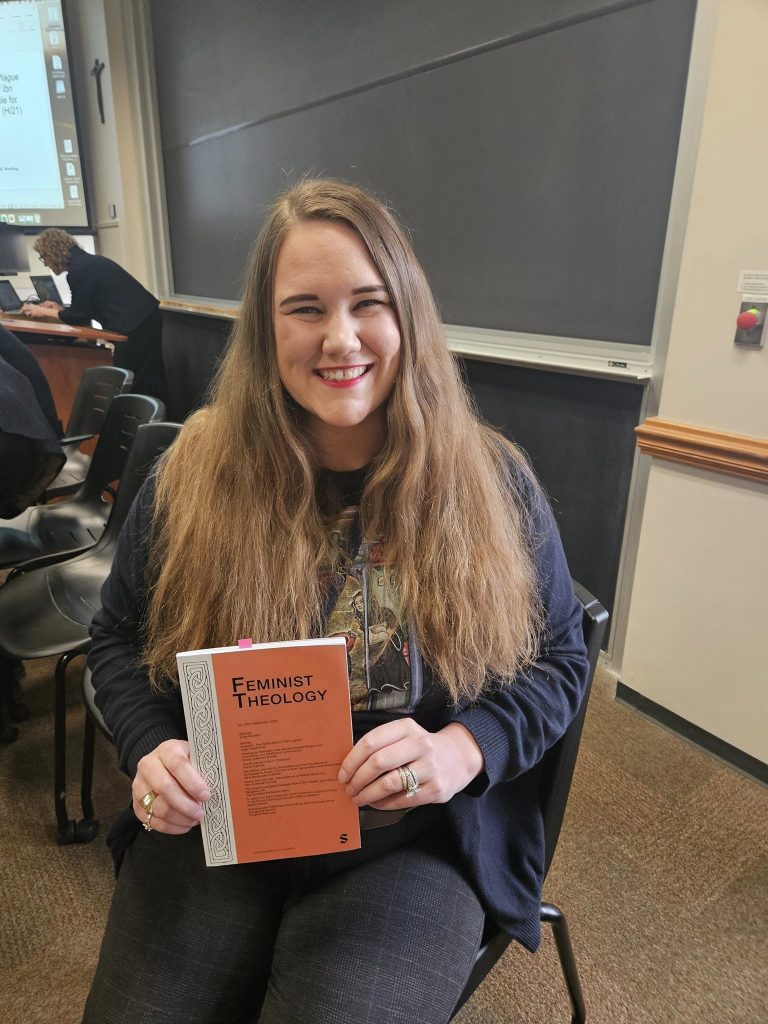
I am holding a copy of the 2023 Feminist Theology journal, in which my paper, Optics and Visio Dei: Interpretations of Female Mystic Art was published. I am preparing to present my paper at the 99th Annual Meeting of the Medieval Academy of America at Notre Dame, Indiana in 2024. Photo Credit: Tory Schendel-Vyvoda.
Additionally, I am embedded into the medieval community because, as of this year, I presented at the 99th Annual Meeting of the Medieval Academy of America and the 59th International Congress on Medieval Studies. I plan to continue my work in the conference circuit, especially since I currently serve as the Medieval Association of the Midwest’s Organizer of Conference Sessions and as a Councilor.
Although I am not a medieval curator, I feel satisfied with my work and am grateful that I have the practical and theoretical skills to move around the humanities and fulfill a variety of needs for my community. Nonetheless, I fully believe that I would be unable to work as I do if it were not for my medieval training. To fully comprehend the Middle Ages, holistic study is required. The era was diverse and had a global impact. Additionally, disciplines such as science, art, and religion collided, and because of their collective force, one must study each discipline to decipher the visual artworks left behind. For example, in Hildegard von Bingen’s Scivias, images such as the Cosmic Egg require multidisciplinary studies to be fully comprehended as it is a visual representation of the universe grounded in theology.[12]

This facsimile of Scivias was available during the 99th Annual Meeting of the Medieval Academy of America at Notre Dame, Indiana in 2024. The image shown is Hildegard’s Cosmic Egg. Photo Credit: Tory Schendel-Vyvoda.
Training your brain to look for patterns across a sea of disciplines has been one of the most fundamental skills I have learned and have been able to apply to my professional work due to my medieval training. Additionally, being a student of medieval studies has taught me there is no need to pigeonhole myself into one discipline or feel bad that I am a multidisciplinary scholar, as I sometimes wish that I did have a specialty like most of my peers. Nonetheless, the medieval period gave me the keys to break out of a traditional “this” or “that” career, and while a “this” or “that” career is perfectly acceptable, failing to be solely a medieval curator has allowed me to move beyond the closed circles of academia to apply my background in medieval studies in contemporary and non-traditional venues to amplify the Middle Ages or share the joy of medievalism.
In conclusion, this reflexive essay explores my lifelong connection to the Middle Ages and demonstrates how one does not need to be a traditional medievalist to have access to this field. For me, this was a difficult lesson to learn because I sometimes speculate how different my professional life would have been if I did not try so hard to be a medieval curator. Of course, it is human to have a dream job and we will always need subject-matter experts, but the humanities sector has evolved, especially since 2020, in which the trivium and the multidisciplinary scholar are on the rise. It is fantastic to witness how colleagues and peers can invent or reinvent themselves professionally based on their passions. Therefore, it is imperative scholars are given space, like through the Different Visions Journal to share their passion journeys in hopes to inspire or encourage the next generation of medieval scholars.
References
| ↑1 | “Crash Bandicoot,” Bandipedia, accessed March 28, 2025, https://crashbandicoot.fandom.com/wiki/Crash_Bandicoot. |
|---|---|
| ↑2 | In the late 1990s, Pizza Hut gave free demo discs of Play Station games with the purchase of certain pizzas. For more information: “Pizza Hut Pizza Powered (PS 1 Demo Disc) : Pizza Hut and Sony Computer Entertainment : Free Download, Borrow, and Streaming,” Internet Archive, October 31, 1998, https://archive.org/details/PizzaHutPizzaPoweredPs1DemoDisc. |
| ↑3 | “Gen Con,” Wikipedia, March 26, 2025, https://en.wikipedia.org/wiki/Gen_Con. |
| ↑4 | William Hosch, “YouTube,” Encyclopædia Britannica, March 27, 2025, https://www.britannica.com/topic/YouTube. |
| ↑5 | Since Tara and I worked at Taco Bell, the general manager allowed us to film in space; however, the video no longer exists on YouTube due to copyrights. |
| ↑6 | “Honors Program in Foreign Languages for Indiana High School Students,” Honors Program in Foreign Languages, accessed March 28, 2025, https://iuhpfl.indiana.edu/index.html. |
| ↑7 | Einhard, David Ganz, and Notker, Two Lives of Charlemagne (London: Penguin Books, 2008). |
| ↑8 | I discuss the impact of interacting with the Bust more in-depth in this interview: Liz Publika, “An Interview with Tory Schendel Cox, Art Curator at the Evansville Museum of Arts, History & Science,” ARTpublika Magazine, July 21, 2020, https://www.artpublikamag.com/post/an-interview-with-tory-schendel-cox-art-curator-at-the-evansville-museum-of-arts-history-science. |
| ↑9 | Kisha G. Tracy, Why Study the Middle Ages? (Arc Humanities Press, 2022). |
| ↑10 | To learn more about the EAAM: Evansville African American Museum, accessed March 28, 2025, http://www.evvaam.org/. |
| ↑11 | Tory Schendel-Vyvoda, “A Tiny Box, Big Dreams: The Lamasco Microgallery as a Nontraditional Venue for Art & Community Engagement,” Collections: A Journal for Museum and Archives Professionals 20, no. 4 (April 11, 2024): 685–94, https://doi.org/10.1177/15501906241246067. |
| ↑12 | Margot Fassler, Cosmos, Liturgy, and the Arts in the Twelfth Century: Hildegard’s Illuminated Scivias (Philadelphia, PA: University of Pennsylvania Press, 2023). https://doi.org/10.9783/9781512823080. |
